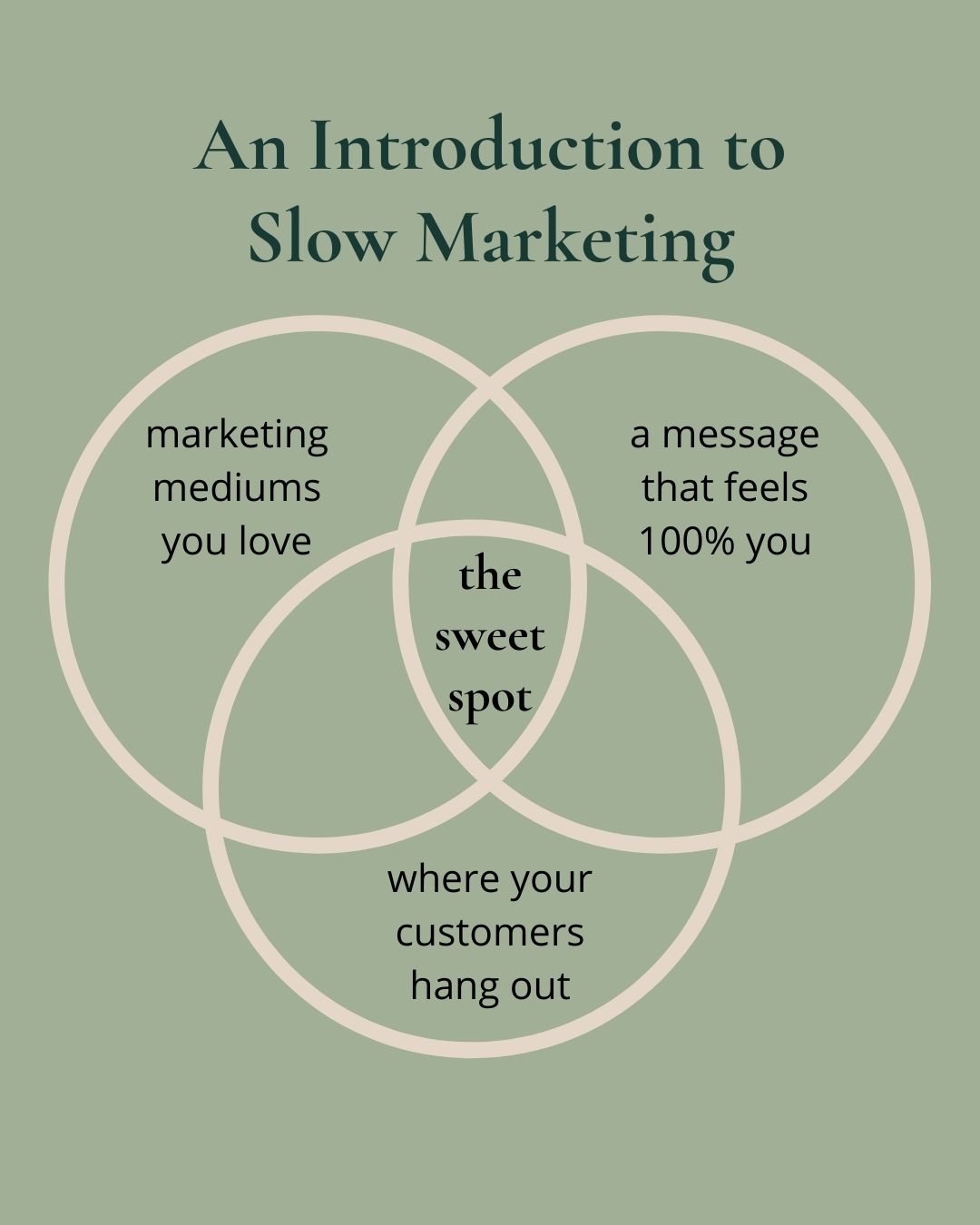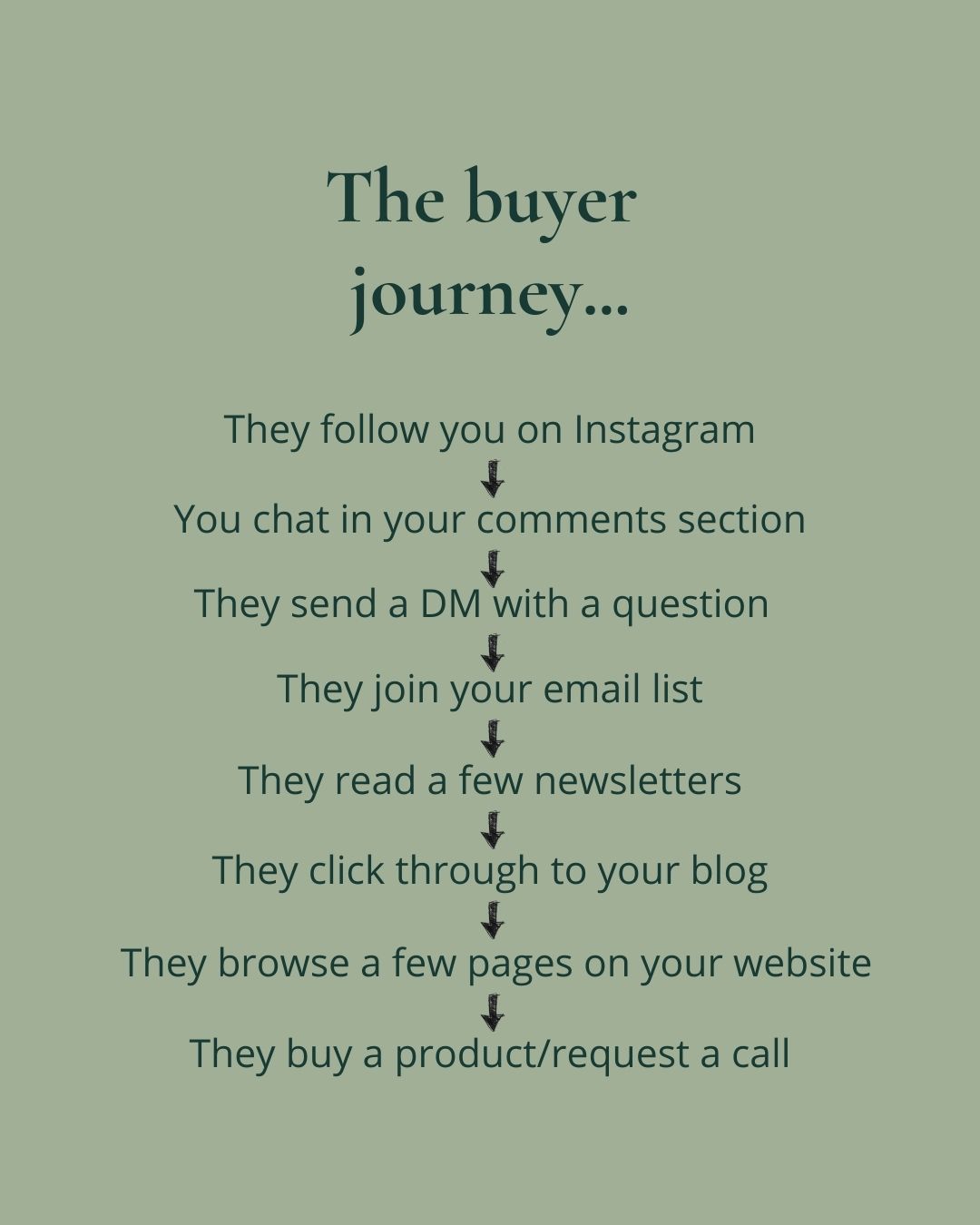The world wants you to live in one way and one way alone… fast. When what we achieve is prioritised over how we feel, when business “experts” are constantly telling us that we should be in all the places at once… and when our foot feels stuck on that accelerator button with no way off… it’s hardly surprising that slow marketing has such an appeal.

There’s a reason why big companies have huge marketing departments running the show. It’s a full-time job (and then some). But does it have to be?
Sure, budgets and resources are limited for small businesses. But I don’t think that’s a bad thing. Not when slow marketing has so much potential…
What is slow marketing?
There are two ways to define slow marketing. The first is slowness of message. And the second? Slowness of medium.
Slowness of message
For most small businesses, this comes naturally. A slower message is a more soulful one. There’s no fast pressure to buy, no aggressive sales techniques or icky marketing spiels.
Instead, marketing messages are gentle and meaningful. Your content holds space for your audience to slow down, take a moment and consider their purchase decision. It’s something that bigger brands are constantly trying to emulate – you can see some examples of those campaigns here, from Waitrose’s slow TV ads to puddles being live-streamed. This is the kind of slow marketing that gets talked about on the big marketing blogs.
Most of the time, people are making an intentional effort to buy from your small business over convenient mainstream brands. They’ve already slowed down to make that choice, so it seems only natural to continue that feeling.
Slowness of medium
Slowness of medium is where, in my opinion, it gets even more interesting. This is where you eschew all the marketing “must-haves” and choose to focus instead on the platforms that work best for your business.
This isn’t about getting quick results. Instead, you prioritise building intentional relationships with your audience. It’s a slower, more meaningful approach to marketing and one that isn’t quite as new as you might think.
It’s easy to draw ties between slow marketing and inbound marketing, an approach to marketing that places an emphasis on attracting customers by creating content and experiences that are designed to serve your dream customers. It’s also the marketing style that started my career, as a Content Marketing Manager at a London start-up.
This is the marketing method that makes the most sense to me. Why interrupt your customers, when you could serve them instead?
The small business approach to slow marketing
It might not always feel like it but, as a small business owner, you’re in a powerful position. You get to decide what marketing style you want to follow, without a board or leadership team breathing down your neck.
When a slow and soulful message meets a slow and soulful medium, that’s where the magic happens.
Rather than saying “I’m going to grow my Instagram this year”, you have the opportunity to take a holistic approach to marketing and improve your customer experience across the board. You can join the dots together and create one seamless experience, no matter where your customers find you.
Just like the slow living movement, slow marketing is all-encompassing. It’s intentional, natural and connected to your business. And yes, it feels more soulful because you’re taking the time to make meaningful decisions for your business, instead of listening to what the marketing pros want you to do.
It’s your small business rebellion.
What results can you expect from slow marketing?
If you’re looking for some quick sales, slow marketing isn’t for you.
It’s… well, you’ve guessed it. It’s slow. But it’s also more sustainable. Because you’re learning as you go, correcting any mistakes along the way and building deeper relationships with your audience.
You’re not asking people to buy from you because you’re the cheapest or most convenient. You’re asking people to buy from you because they feel connected to you and your brand. It’s the difference between grabbing an espresso from Starbucks at the motorway service station, and your daily trip to your local coffee shop where the baristas all know your name.
And, you get to feel better about yourself along the way. There’s no icky marketing techniques, as you’re focusing on creating value for your customers instead.
How to get started with slow marketing
1. Get to know your audience
Every marketer will tell you to get to know your audience before putting any marketing plan together. But what do they really mean by that?
Instead of building up lists of ages groups and marital statuses, we want to go deeper than that. If you’re going to build a meaningful relationship with your audience, what do you need to know about them?
You’re going to need to understand their wants, needs, desires, concerns and questions. You’ll need to know why they’d want to buy from a business like yours, and what’s likely to hold them back along the way.
So, once a year, make it a habit to check in with your audience. Create surveys, run interviews, analyse your reviews, check-in with casual conversations, listen to what they’re saying on social media… and ask open-ended questions to really get to know them.
2. Look for where you can add value
The three golden rules of content are that it needs to either educate, inspire or entertain your reader. In short, it needs to serve a purpose and have value.
- Educate – what common misconceptions are there surrounding your industry? What do you wish people knew about your work? What questions do your customers always have? How can you support them?
- Inspire – how can your customers bring your products to life in their homes? What stories do you have of other customers using your product or service in an unexpected way? What new methods or techniques will spark some fresh ideas for your readers?
- Entertain – I always think this one makes it sound like you need to be a comedian, but that really isn’t the case. Instead, consider how you can build connections. What common gripes do your customers have? Are there shared passions, or frustrations? How can you speak to them in your content?
3. Look for the mediums that speak to you
You’re told to make your marketing all about your customers… but what’s the point of that if you’re dreading every second? That’s going to come across in your message.
Instead, look for the marketing channels that appeal to you. And then look for the crossover. Are your customers spending time on these platforms too? That’s when you know you’ve hit the sweet spot.

4. Create a customer path
Your customer path is also known as your customer journey. This is the route your customers take before they buy from you – from the first point of contact right down to the moment they make that purchase.

It can take around 10 points of contact before a customer finally clicks that “buy” button. So you’re going to want to think about how you can nurture them along the way. What resources can you create to help them navigate that journey in the smoothest way possible?
5. Learn as you go
You’re not going to get it right the first time. Nobody ever does.
Instead, be open to learning as you go. Look for the lessons and write them down. Then, set aside some time to check in with your plans each month. You’ll get there, it’ll be worth the wait.

